Fractal Analysis on the Crushing Characteristics of Soil-Soft Rock Mixtures under Compaction
Abstract
1. Introduction
2. Experiments and Methods
2.1. Experimental Instrument and Materials
2.2. Experimental Scheme
2.3. Particle Fractal Model
3. Results and Discussion
3.1. Compaction Characteristics of SSRM
3.2. Particle Crushing Characteristics
3.3. Particle Fractal Analysis
3.4. Relationship between Particle Crushing and Fractal Dimension
3.5. Relationship between Dry Density and Fractal Dimension
4. Conclusions
Author Contributions
Funding
Data Availability Statement
Conflicts of Interest
References
- Xu, W.J.; Hu, R.L. Conception, classification and significations of soil-rock mixture. Hydrogeol. Eng. Geol. 2009, 36, 50–56+70. [Google Scholar]
- Xing, K.; Zhou, Z.; Yang, H.; Liu, B.C. Macro-meso freeze-thaw damage mechanism of soil-rock mixtures with different rock contents. Int. J. Pavement Eng. 2020, 21, 9–19. [Google Scholar] [CrossRef]
- He, Y.; Li, Y.Y.; Evans, T.J.; Yu, A.B.; Yang, R.Y. Effects of particle characteristics and consolidation pressure on the compaction of non-spherical particles. Miner. Eng. 2019, 137, 241–249. [Google Scholar] [CrossRef]
- Liu, H.D.; Liu, J.J.; Zhang, S.Y.; Feng, L.Y.; Qiu, L. Stress–strain and acoustic emission characteristics of cement-based materials used to simulate soft rock with fractures. Sci. Rep. 2022, 12, 7903. [Google Scholar] [CrossRef] [PubMed]
- Zou, J.F.; Sheng, Y.M.; Xia, Z.Q. Dynamic stress properties of dynamic compaction (DC) in a red-sandstone soil-rock mixture embankment. Environ. Earth Sci. 2017, 76, 411. [Google Scholar]
- Kang, S.; Kim, G.; Wi, J.; Ahn, T.; Lee, D.S.; Choi, H. Effect of Particle Breakage on Compaction and Thermal Resistivity of Concrete-based Recycled Aggregates. J. Korean Geotech. Soc. 2015, 31, 17–28. [Google Scholar] [CrossRef][Green Version]
- Zhang, H.Y.; Xu, W.J.; Yu, Y.Z. Triaxial tests of soil–rock mixtures with different rock block distributions. Soils Found. 2016, 56, 44–56. [Google Scholar] [CrossRef]
- Wu, M.Q.; Li, H.T.; Wang, L.; Yang, X.L.; Yang, N.; Yu, M.G. Compaction-deformation behaviors and breakage characteristics of loose broken coal under various stress-temperature coupling loads. Fuel 2023, 353, 129083. [Google Scholar] [CrossRef]
- Liu, Y.M.; Liu, H.B.; Mao, H.J. DEM investigation of the effect of intermediate principle stress on particle breakage of granular materials. Comput. Geotech. 2017, 84, 58–67. [Google Scholar] [CrossRef]
- Wang, L.; Zhu, J.G.; Zhang, Z.L.; Zheng, H.F. Effects of dry density on shear behavior and particle breakage for slate rockfill material. Bull. Eng. Geol. Environ. 2021, 80, 1181–1192. [Google Scholar] [CrossRef]
- Du, J.; Xiong, Z.M.; Shen, X.G.; Li, C.C. Experimental Study on the Effect of Coarse Grain Content on the Dilatancy and Particle Breakage Characteristics of Coarse-Grained Soils. Geofluids 2023, 2023, 2307881. [Google Scholar] [CrossRef]
- Pang, M.K.; Pan, H.Y.; Yang, S.H.; Zhu, S.P.; Zhang, T.J. Experimental Investigation of the Compaction-Crushing Characteristics of Graded Fractured Coal Gangue Based on Infill Mining. Fractal Fract. 2023, 7, 33. [Google Scholar] [CrossRef]
- Wang, L.Z.; Yin, M.G.; Kong, H.L.; Zhang, H.L. Experimental Study on Breakage Characteristics and Energy Dissipation of the Crushed Rock Grains. KSCE J. Civ. Eng. 2022, 26, 1465–1478. [Google Scholar] [CrossRef]
- Hashemnejad, A.; Aghda, S.M.F.; Talkhablou, M. Introducing a new classification of soft rocks based on the main geological and engineering aspects. Bull. Eng. Geol. Environ. 2021, 80, 4235–4254. [Google Scholar] [CrossRef]
- Bryson, L.S.; Mahmoodabadi, M.; Gomez-Gutierrez, I.C. Mechanical Behavior of Weathered Compacted Shales. Geotech. Geol. Eng. 2023. [Google Scholar] [CrossRef]
- Zhang, C.; Liu, J.B.; Zhao, Y.X.; Han, P.H.; Zhang, L. Numerical Simulation of Broken Coal Strength Influence on Compaction Characteristics in Goaf. Nat. Resour. Res. 2020, 29, 2495–2511. [Google Scholar] [CrossRef]
- Zhang, C.; Ren, Z.P.; Hao, D.Y.; Zhang, T. Numerical Simulation of Particle Size Influence on the Breakage Mechanism of Broken Coal. Arab. J. Sci. Eng. 2020, 45, 9171–9185. [Google Scholar] [CrossRef]
- Bai, J.W.; Tang, H.F.; Hu, J.; Yang, L.Y.; Guo, T.C.; Zhang, Z.Q. Characteristics and Controlling Factors of Particle Crushing in Volcaniclastic Sediments under Compaction: The Quaternary Pyroclastic Deposits of Hongtu Hill, Changbaishan Area, Northeastern China. Minerals 2023, 13, 1351. [Google Scholar] [CrossRef]
- Zhang, J.X.; Li, M.; Liu, Z.; Zhou, N. Fractal characteristics of crushed particles of coal gangue under compaction. Powder Technol. 2017, 305, 12–18. [Google Scholar] [CrossRef]
- Li, Z.; Yang, X.J.; Yang, P.; Feng, G.R.; Liu, J.Y.; Zhu, C.Q.; Cheng, X. Layered re-breaking behavior of gangue backfilling materials and inspirations for protecting mined ecological environments. Constr. Build Mater. 2023, 368, 130477. [Google Scholar] [CrossRef]
- Li, B.; Liang, Y.P.; Zhang, L.; Zou, Q.L. Breakage law and fractal characteristics of broken coal and rock masses with different mixing ratios during compaction. Energy Sci. Eng. 2019, 7, 1000–1015. [Google Scholar] [CrossRef]
- Li, B.; Liang, Y.P.; Zhang, L.; Zou, Q.L. Experimental investigation on compaction characteristics and permeability evolution of broken coal. Int. J. Rock Mech. Min. 2019, 118, 63–76. [Google Scholar] [CrossRef]
- ASTM-D698; Standard Test Methods for Laboratory Compaction Characteristics of Soil Using Standard Effort (12,400 ft-lbf/ft3 (600 kN-m/m3)). ASTM: West Conshohocken, PA, USA, 2012.
- GS/T 50123-2019; Ministry of Housing and Urban-Rural Development of the People’s Republic of China. Standard for Geotechnical Testing Method. China Planning Press: Beijing, China, 2019.
- Zhao, Y.X.; Liu, Z.X. Study of Material Composition Effects on the Mechanical Properties of Soil-Rock Mixtures. Adv. Civ. Eng. 2018, 2018, 3854727. [Google Scholar] [CrossRef]
- Yang, Z.P.; Li, J.; Liu, H.Y.; Zhang, Y.M.; Liu, X.R. Influence of the block stone size on shear mechanical behavior of soil-rock mixture-bedrock interface. Rock Soil Mech. 2023, 44, 965–974. [Google Scholar]
- Han, H.X.; Li, J.; Shi, J.C.; Yang, C.N. Influence of Scale Effect on Strength and Deformation Characteristics of Rockfill Materials. Materials 2022, 15, 5467. [Google Scholar] [CrossRef] [PubMed]
- Medley, E.W.; Zekkos, D. Geopractitioner approaches to working with antisocial mélanges. Geol. Soc. Am. Spec. Pap. 2011, 480, 261–277. [Google Scholar]
- Wang, Q.; Hu, X.L.; Xu, Y.; Zhou, C.; Xu, C. Investigation on compaction characteristics and meso-mechanism of soil-rock mixture with soft rock blocks. J. Zhejiang Univ. (Eng. Sci.) 2018, 52, 2295–2305. [Google Scholar]
- ASTM-D4718; Standard Practice for Correction of Unit Weight and Water Content for Soils Containing Oversize Particles. ASTM: West Conshohocken, PA, USA, 2015.
- Feda, J. Notes on the effect of grain crushing on the granular soil behaviour. Eng. Geol. 2002, 63, 93–98. [Google Scholar] [CrossRef]
- Liu, Y.; Sun, S.R.; Wei, J.H.; Song, J.L.; Yu, Y.X.; He, W.; Zhang, J.X. Mechanical characteristics of soil-rock mixtures containing macropore structure based on 3D modeling technology. J. Mt. Sci. 2020, 17, 2224–2240. [Google Scholar] [CrossRef]
- Ji, X.P.; Lu, H.L.; Dai, C.; Ye, Y.G.; Cui, Z.F.; Xiong, Y. Characterization of Properties of Soil–Rock Mixture Prepared by the Laboratory Vibration Compaction Method. Sustainability 2021, 13, 11239. [Google Scholar] [CrossRef]
- Ji, X.P.; Han, B.; Hu, J.M.; Li, S.W.; Xiong, Y.; Sun, E.Y. Application of the discrete element method and CT scanning to investigate the compaction characteristics of the soil–rock mixture in the subgrade. Road Mater. Pavement Des. 2022, 23, 397–413. [Google Scholar] [CrossRef]
- Yan, X.; Zhan, W.; Hu, Z.; Yu, Y.Q.; Xiao, D.Q. Experimental Study on the Effect of Compaction Work and Defect on the Strength of Soil-Rock Mixture Subgrade. Adv. Mater. Sci. Eng. 2021, 2021, 5533590. [Google Scholar] [CrossRef]
- Mandelbrot, B.B. Fractal Analysis and Synthesis of Fracture Surface Roughness and Related Forms of Complexity and Disorder. Int. J. Fract. 2006, 138, 13–17. [Google Scholar] [CrossRef]
- Shi, X.S.; Cheng, Z.L. Fractal behavior in crushing of rockfill material. Chin. J. Rock Mech. Eng. 2010, 29, 3852–3857. [Google Scholar]
- Zhang, P.; Jin, L.; Du, X.L.; Lu, D.C. Computational homogenization for mechanical properties of sand cobble stratum based on fractal theory. Eng. Geol. 2018, 232, 82–93. [Google Scholar] [CrossRef]
- Fu, X.D.; Ding, H.F.; Sheng, Q.; Zhang, Z.P.; Yin, D.W.; Chen, F. Fractal Analysis of Particle Distribution and Scale Effect in a Soil-Rock Mixture. Fractal Fract. 2022, 6, 120. [Google Scholar] [CrossRef]
- Tasdemir, A. Fractal evaluation of particle size distributions of chromites in different comminution environments. Miner. Eng. 2009, 22, 156–167. [Google Scholar] [CrossRef]
- Zhang, Z.P.; Fu, X.D.; Yuan, W.; Sheng, Q.; Chai, S.B.; Du, Y.X. The Influence of the Fractal Dimension on the Mechanical Behaviors of the Soil–Rock Mixture: A Case Study from Southwest China. Fractal Fract. 2023, 7, 106. [Google Scholar] [CrossRef]
- Tu, Y.L.; Liu, X.R.; Ren, Q.Y.; Chai, H.J.; Wang, J.B.; Yu, J.Y. Effects of rock contents and particle breakage on strength characteristics of soil-rock aggregate. Rock Soil Mech. 2020, 41, 3919–3928. [Google Scholar]
- Bonagiri, V.; Arif, A.B.M.; Ateekh, U.R.; Bhaskar, C.S.C. Shear, Consolidation Characteristics and Carbon Footprint Analysis of Clayey Soil Blended with Calcium Lignosulphonate and Granite Sand for Earthen Dam Application. Sustainability 2023, 15, 6117. [Google Scholar]
- Romana, M.R.; Arif, A.B.M.; Sathyanarayanan, R.; Abdullah, A. Sustainable assessment and carbon footprint analysis of polysaccharide biopolymer-amended soft soil as an alternate material to canal lining. Front. Environ. Sci. 2023, 11, 1214988. [Google Scholar]
- Marsal, R.J. Coarse-scale testing of rockfills materials. J. Soil Mech. Found. Eng. ASCE 1967, 93, 27–44. [Google Scholar] [CrossRef]
- Wang, J.J.; Cheng, Y.Z.; Zhang, H.P.; Deng, D.P. Effects of particle size on compaction behavior and particle crushing of crushed sandstone-mudstone particle mixture. Environ. Earth Sci. 2015, 73, 8053–8059. [Google Scholar] [CrossRef]
- Wu, D.T.; Guo, W.B.; Luo, F.; Li, M. Simulation experimental investigations on particle breakage mechanism and fractal characteristics of mixed size gangue backfill materials. J. Mater. Res. Technol-JMRT 2023, 24, 125–142. [Google Scholar] [CrossRef]
- Zhang, M.; Zhang, S.L.; Xu, Y.; Zhang, W.L.; Yuan, C.W.; Xie, H.L. Study on correlation between fractal characteristics and shear strength of bimsoils. Bull. Eng. Geol. Environ. 2023, 82, 338. [Google Scholar] [CrossRef]

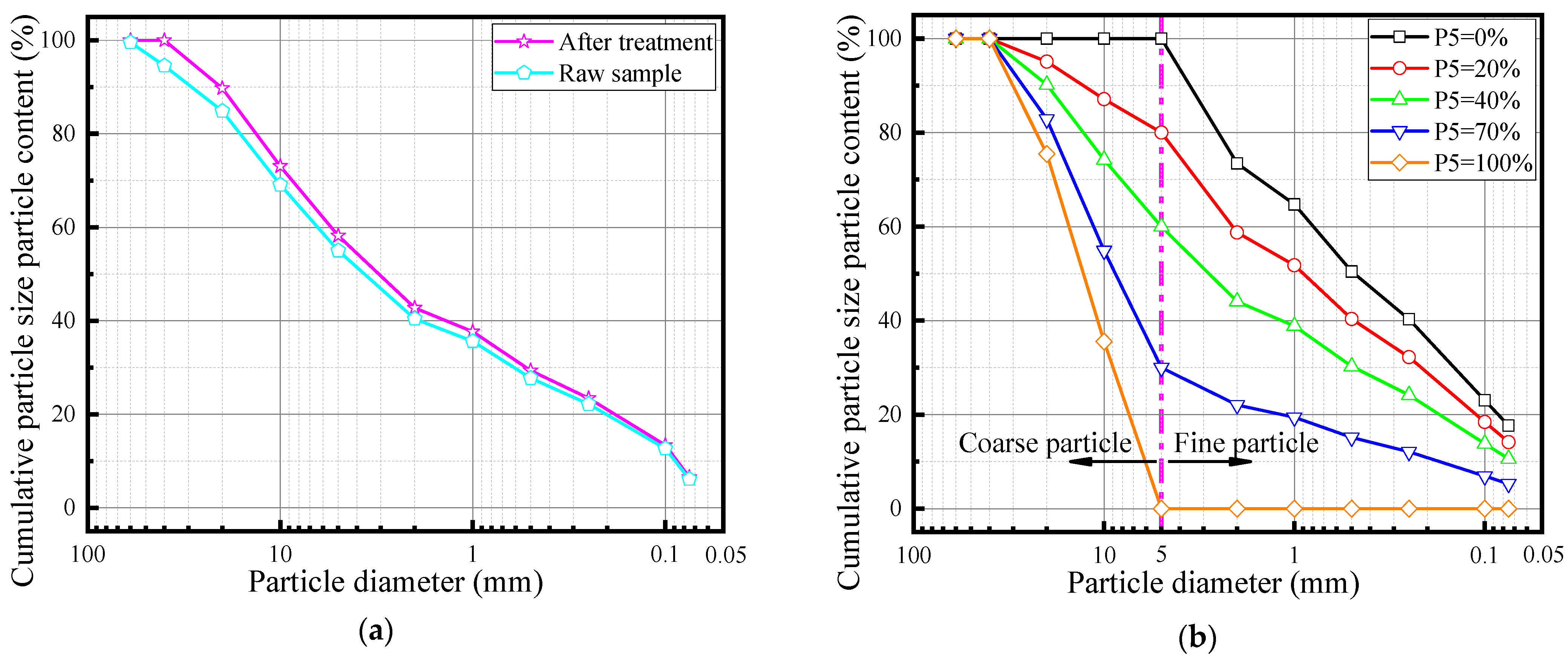


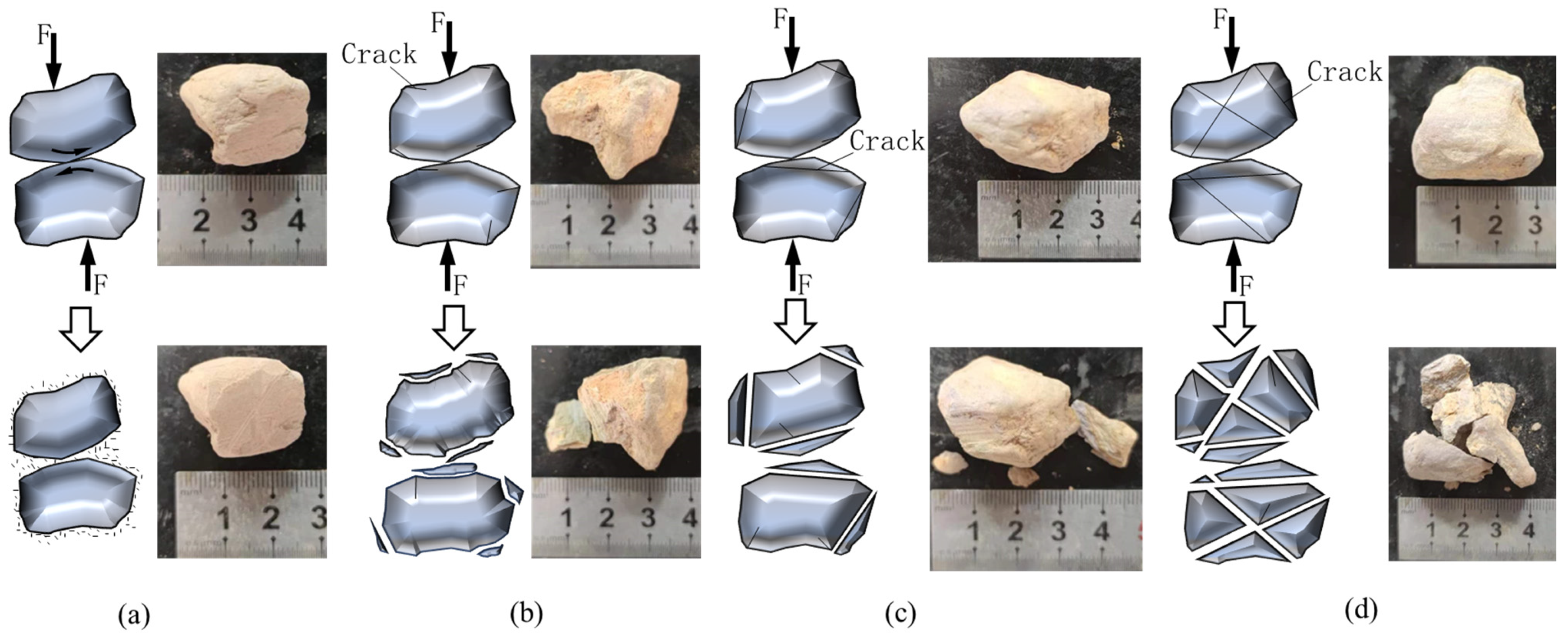


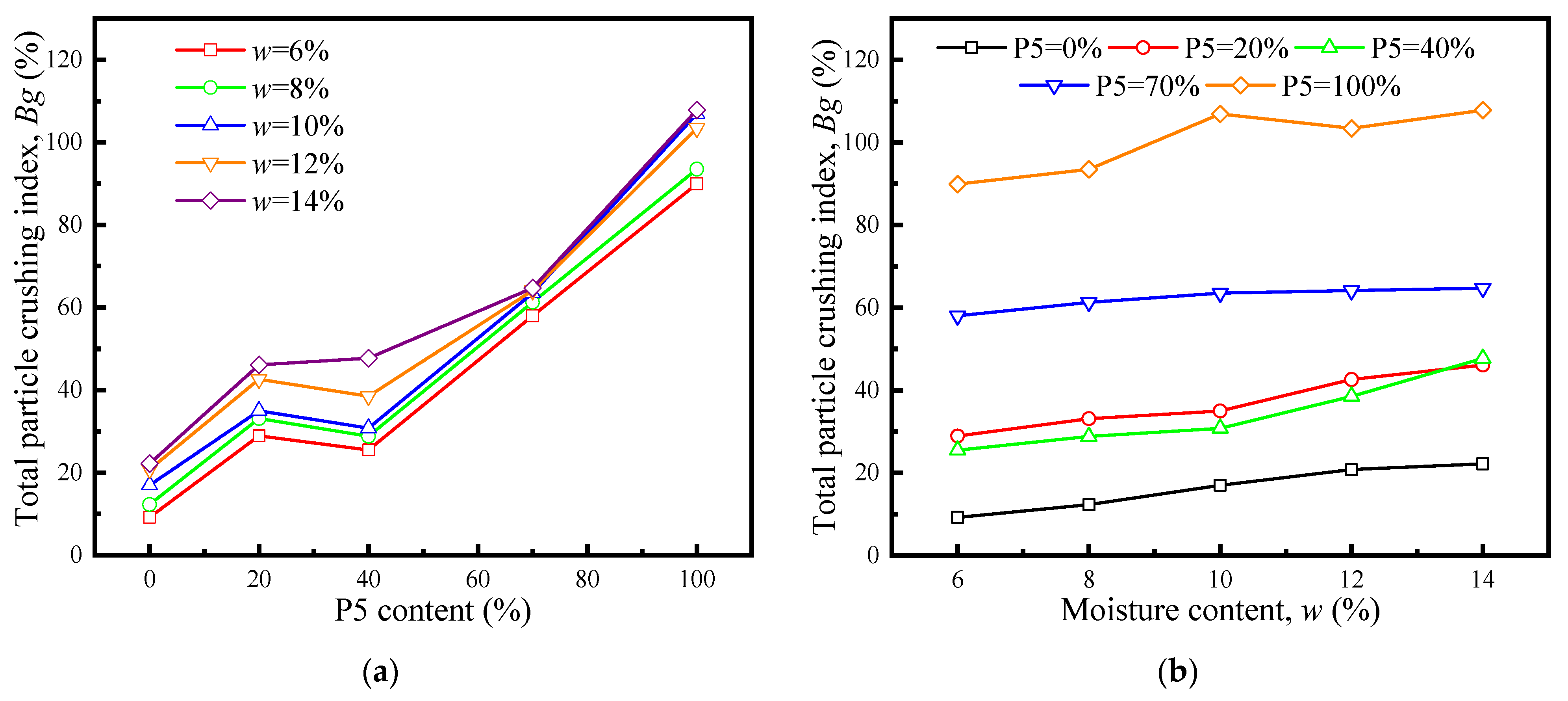


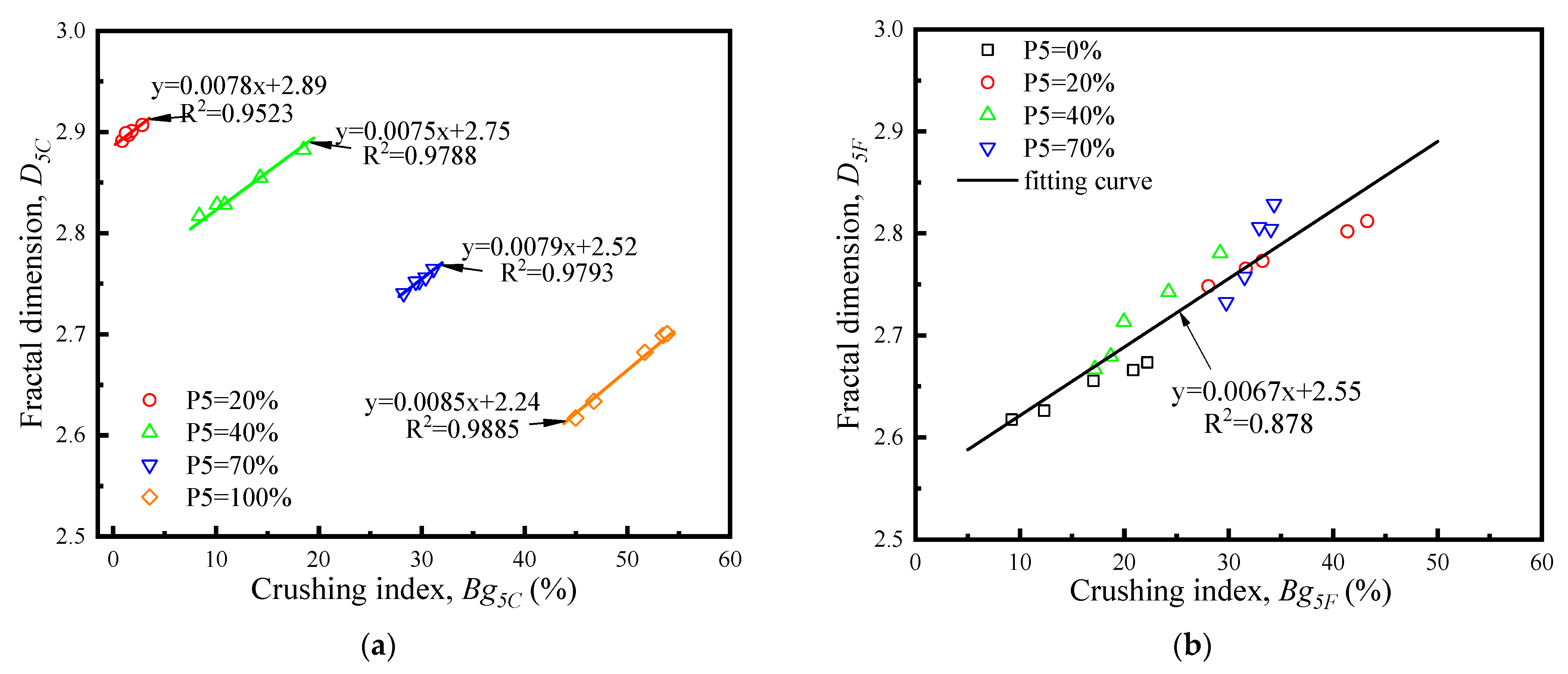

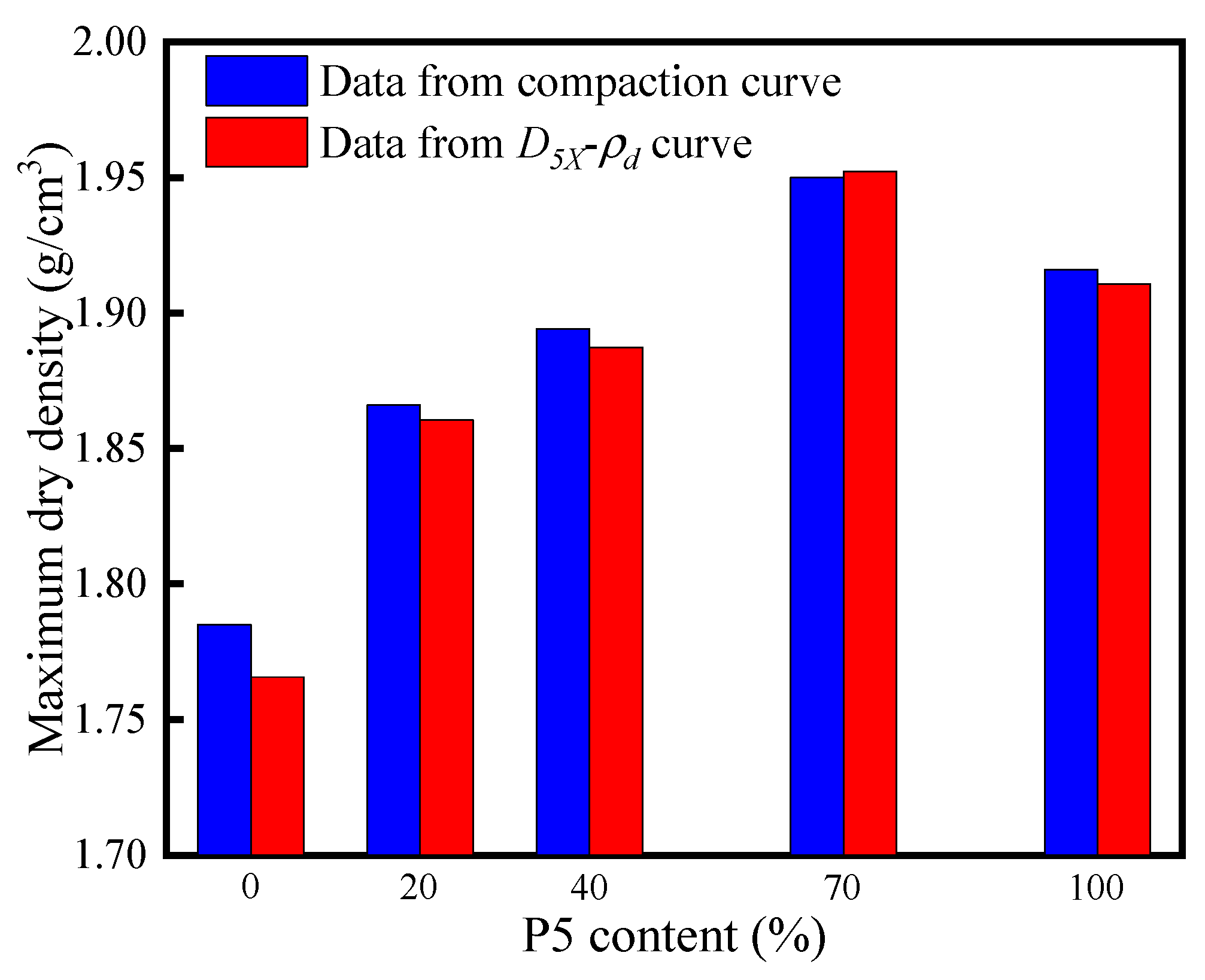
| P5/% | D5C | D5F | D |
|---|---|---|---|
| 0 | / | 2.6039 | 2.6039 |
| 20 | 2.8908 | 2.6039 | 2.6988 |
| 40 | 2.7508 | 2.6039 | 2.6579 |
| 70 | 2.4196 | 2.6039 | 2.5534 |
| 100 | 2.2542 | / | 2.2542 |
| Moisture Content w/% | P5 Content/% | ||||||||
|---|---|---|---|---|---|---|---|---|---|
| 0 | 20 | 40 | 70 | 100 | |||||
| D5F | D5C | D5F | D5C | D5F | D5C | D5F | D5C | D5F | |
| 6 | 2.617 | 2.891 | 2.748 | 2.817 | 2.667 | 2.741 | 2.732 | 2.617 | 2.693 |
| 8 | 2.626 | 2.897 | 2.765 | 2.828 | 2.679 | 2.753 | 2.758 | 2.634 | 2.740 |
| 10 | 2.655 | 2.901 | 2.773 | 2.828 | 2.713 | 2.752 | 2.804 | 2.699 | 2.784 |
| 12 | 2.666 | 2.899 | 2.802 | 2.855 | 2.742 | 2.765 | 2.806 | 2.682 | 2.783 |
| 14 | 2.674 | 2.907 | 2.812 | 2.882 | 2.780 | 2.756 | 2.829 | 2.701 | 2.810 |
Disclaimer/Publisher’s Note: The statements, opinions and data contained in all publications are solely those of the individual author(s) and contributor(s) and not of MDPI and/or the editor(s). MDPI and/or the editor(s) disclaim responsibility for any injury to people or property resulting from any ideas, methods, instructions or products referred to in the content. |
© 2024 by the authors. Licensee MDPI, Basel, Switzerland. This article is an open access article distributed under the terms and conditions of the Creative Commons Attribution (CC BY) license (https://creativecommons.org/licenses/by/4.0/).
Share and Cite
Hu, F.; Zhang, K.; Zhu, K.; Li, B.; Zhang, Z.; He, Y. Fractal Analysis on the Crushing Characteristics of Soil-Soft Rock Mixtures under Compaction. Fractal Fract. 2024, 8, 90. https://doi.org/10.3390/fractalfract8020090
Hu F, Zhang K, Zhu K, Li B, Zhang Z, He Y. Fractal Analysis on the Crushing Characteristics of Soil-Soft Rock Mixtures under Compaction. Fractal and Fractional. 2024; 8(2):90. https://doi.org/10.3390/fractalfract8020090
Chicago/Turabian StyleHu, Fengyun, Keneng Zhang, Kaofei Zhu, Bintian Li, Zhao Zhang, and Yong He. 2024. "Fractal Analysis on the Crushing Characteristics of Soil-Soft Rock Mixtures under Compaction" Fractal and Fractional 8, no. 2: 90. https://doi.org/10.3390/fractalfract8020090
APA StyleHu, F., Zhang, K., Zhu, K., Li, B., Zhang, Z., & He, Y. (2024). Fractal Analysis on the Crushing Characteristics of Soil-Soft Rock Mixtures under Compaction. Fractal and Fractional, 8(2), 90. https://doi.org/10.3390/fractalfract8020090







